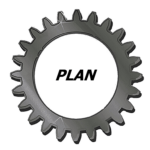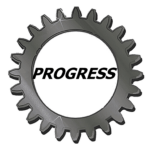Force Field Analysis
Force Field Analysis aids in identifying the forces that drive or hinder change, which organizations and individuals can effectively strategize and make informed decisions to overcome obstacles to unlock their full potential.

Chapter 1: What is it?

Change is an inevitable part of life, whether it be on a personal or organizational level. However, understanding the forces that drive or hinder change is essential for successfully navigating through it. Force Field Analysis is a powerful tool that helps us identify and evaluate the various factors influencing change, allowing us to make informed decisions and develop effective strategies. By comprehensively examining both the driving and restraining forces, we can gain valuable insights into the dynamics at play and take appropriate actions to facilitate desired change. This article aims to provide a comprehensive overview of Force Field Analysis, its methodology, and its applications.
Chapter 2 : When do I use it?

In the world of strategic planning, success is not merely a matter of setting goals and working towards them. It requires a deep understanding of the forces that can drive or hinder progress. This is where the power of Force Field Analysis comes into play. By adopting this invaluable tool, individuals and organizations can unlock their potential and achieve success like never before. In this article, we will explore how embracing Force Field Analysis can unleash your potential and empower your planning.
Chapter 3: How do I use it?

We all have goals and dreams we strive to achieve, but sometimes it can feel like there are invisible forces holding us back. Force Field Analysis is a technique that helps you uncover these hidden forces and empowers you to overcome them. By understanding the driving forces that propel you forward and the restraining forces that impede your progress, you can take control of your productivity and accomplish more than you thought possible.
To begin your Force Field Analysis session, gather a group of like-minded individuals or work on it individually. Start by defining the specific goal or problem you want to address. It could be anything from enhancing your personal productivity to streamlining a team project. Draw a line down the middle of a piece of paper, creating two columns. Label the left column “Driving Forces” and the right column “Restraining Forces.”
Next, brainstorm all the factors that contribute to your productivity and list them under the appropriate column. Driving forces may include motivation, skill sets, supportive team members, and helpful tools or resources. On the other hand, restraining forces could be distractions, lack of time, inadequate training, or any other factors that hinder your progress. Once you have exhausted your ideas, it’s time to analyze and prioritize them.
Now that you have identified the driving and restraining forces, it’s time to analyze their impact on your productivity. Assign a numerical value to each factor, indicating its relative strength or importance. For example, you can use a scale of 1 to 3, with 1 being the most manageable or visible and 3 being the least manageable or visible. This step will help you understand which factors have the most significant influence on your productivity and allow you to focus your efforts accordingly.
After assigning values, take a moment to evaluate the forces that have the highest scores. These are the key factors that greatly impact your productivity, whether positively or negatively. By recognizing these productivity boosters, you can leverage them to your advantage. Conversely, for those restraining forces with high scores, identify ways to mitigate or eliminate them. It could involve seeking additional support, planning better, or finding alternative solutions.
Chapter 4 :Why should I use it?

Force Field Analysis is a powerful tool that has proven to be a game-changer in driving progress and achieving optimum results. By understanding the forces that drive or hinder change, organizations and individuals can effectively strategize and make informed decisions to overcome obstacles and unlock their full potential.
Chapter 5 : Coaching Benefits
![]()
I need help…
Not all help costs money. Requests for additional information and potential application for your industry, helps us to improve the training experience, at no charge to you.
When do I need coaching services?
Coaching has proven time and time again to be a powerful tool in optimizing performance and driving efficiency in various aspects of life. Whether it is in the workplace, educational settings, or even within personal relationships, coaching has the ability to unlock untapped potential and enhance productivity. By leveraging the collective intelligence and diverse skills of a group, individuals can capitalize on their strengths, overcome challenges, and achieve remarkable results.
What do I get with coaching services?
Our Role – Quality coordinating – Work to understand your system, review your needs, and suggest process improvements.
We help you use a chosen template and apply it to your business model, with or without action plans.
Coaching includes personalized shareable document for use or for future coaching.
1 hour online coaching (one on one coaching) no minimum participates

Download a Force Field Analysis Template
Templates are like a secret weapon in the arsenal of content creators. They provide a foundation, a starting point that saves us time and energy.
Mobile Format
By using Google Docs we offer an extensive selection of free templates, covering various categories with no special apps to download making them truly mobile. These templates are also available in Microsoft Word format. These templates are designed by professionals, ensuring a polished and visually appealing outcome. With a few clicks, we can have a well-structured document, complete with headings, subheadings, and placeholders for our content. These templates act as a guiding hand, making it easier for us to organize our thoughts and ideas effectively. They eliminate the need to spend hours formatting and styling our documents, enabling us to focus on the content creation itself.
Simplify Creation Content
The true power of templates lies in their ability to simplify and streamline the content creation process. By using pre-designed layouts and formats, we can save valuable time and effort. Rather than starting from a blank canvas and grappling with design decisions, we can simply choose a template that aligns with our desired style and purpose. This not only speeds up the creation process but also ensures a consistent and professional look for our content.
Templates also allow for customization, enabling us to personalize the document according to our needs. This level of flexibility empowers us to create visually stunning content without the need for advanced design skills. Templates break down the barriers between creativity and execution, making content creation accessible to all.
Unleash Your Creativity
Effortless content creation is within our reach, thanks to the power of free templates in Google Docs and Microsoft Word. By utilizing these templates, we can simplify our workflows, save time, and produce high-quality content without the need for extensive design knowledge. Unlocking the potential of templates allows us to focus on what truly matters – our ideas, thoughts, and messages. So why start from scratch when we have a vast library of templates waiting to be explored? Embrace the convenience and unleash your creativity by utilizing the power of free templates in your next content creation endeavor.
What is a Force Field Analysis?
Watch this video.
Force Field Analysis is a powerful decision-making tool used in various fields, including organizational development, change management, and project management. It helps identify and evaluate the forces that drive change and those that resist it, providing a visual representation of the dynamic balance between these opposing forces.
As You Watch This Video
As you watch this video to understand the available template;
1. There are both positive driving forces and negative retaining forces against change.
2. The goal is to strengthen positive driving force while weakening negative restraining forces.
3. Helps you to answer, do we go ahead with a change?
4. Force Field Analysis increases your chances of success.
5. Start with a statement of intent. Describe the plan or proposal for change.
6. List the factors that support change, like the benefits, who is supporting it, possibly how the change may be accepted.
7. Now list the factors that resist change, like time to implement, needed resources, costs involved, processes affected and potential risk to be encountered.
8. Scoring may be optional. New concept may require that all actions need to be addressed. Rating can be helpful in prioritizing projects to change existing systems and operations.
Still need to visualize, understand the design of the Force Field Analysis and how the method is tested, see the following case studies.

Case Study 1 - Led to Manage LLC
Why did we use a Force Field Analysis?
After the initial SWOT analysis (see Purpose Defining Course – SWOY Analysis) was done, Prototype actions were generated that needed breakout to viable actionable items.
The owner and operations manager lead the initial brainstorming and affinity diagram addressing the prototype website requirements envisioned by the owner.
The owner wanted to align the organization at that time to create an initial website mission list to create the driving core requirements to full website creation.
To understanding the driving and restraining force that the core development team was currently facing and to understand what time, energy and resources needs were needed, the first Forces Field Analysis, shown here was created.
Lessons Learned
1. After brainstorming and doing an affinity diagram exercise (see Progress Developing Course – Brainstorming / Affinity Diagram), the header columns made great starters for identifying the items listed beneath that needed to be addressed with viable action items.
2. After listing each item as either a driving or restraining force, we started with viable actions that would strengthen the driving forces, so that in the course of developing the initial website, they did not soon become a restraining force.
3. Next we addressed each restraining force to mitigate its impact on the website development process with viable actions not addressed previously in the driving force action items section of the template.
4. We chose not to rate this initial Force Field Analysis because all the action items were a priority to complete before Prelaunch, so they were listed the most immediate action items needing to be accomplished first, then lesser obstacles after, by order of current resource availability and then assigned action items, responsibilities, and due dates to the team members.